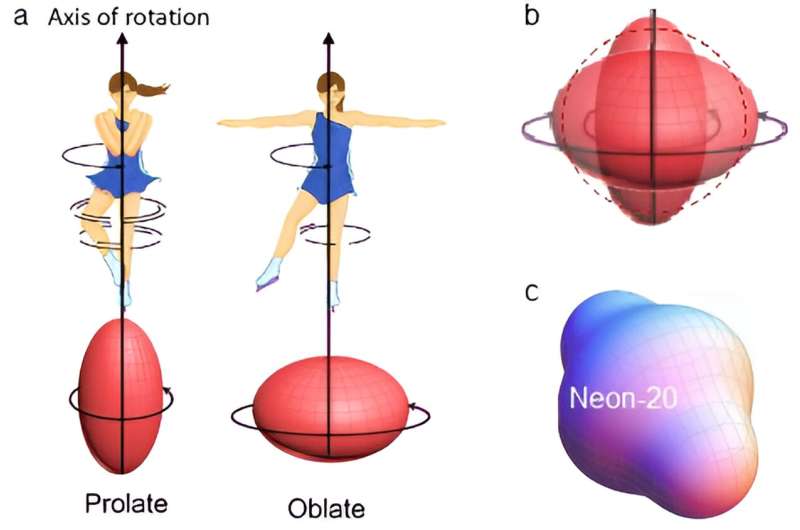This article has been reviewed according to Science X's editorial process and policies. Editors have highlighted the following attributes while ensuring the content's credibility:
fact-checked
peer-reviewed publication
trusted source
proofread
Scientists resolves a long-debated anomaly in how nuclei spin

Atomic nuclei come in different shapes, varying from football-like ("prolate") to pancake-like ("oblate"). Prolate and oblate shapes have different moments of inertia. This is a body's resistance to having its speed of rotation altered by an external force. Atomic nuclei having different shapes with different moments of inertia implies that it takes different amounts of energy to spin different nuclei.
In previous research, measurements found that for fast rotations, for example in nuclei like neon-20 or chromium-48, the energy for spinning changes unexpectedly. Scientists attributed this to an anomalous increase in the moment of inertia for fast rotations, likely due to the nuclear matter bulging out. Earlier models suggested that fast-rotating nuclei ultimately become spheres, but newer models have found deformed shapes. Now, large-scale simulations of atomic nuclei have revealed surprising new explanations of the elusive physics of fast-spinning nuclei.
For the first time in nearly 50 years, scientists accurately calculated the moment of inertia and studied its hypothesized anomalous increase through state-of-the-art simulations of nuclei. The simulations for neon-20 replicate the energy measurements. Remarkably, however, the simulations do not find the anomalous increase. Instead, they reveal a change in the interior of the nucleus.
Similar microscopic simulations for chromium-48 confirm this surprising result. Furthermore, the results resolve the long-lasting question of whether a prolate nucleus that starts to quickly spin becomes spherical or oblate. This research, published in Physical Review C, shows that several competing shapes emerge, some prolate and some oblate, which on average appear spherical.
A student in the Research Experiences for Undergraduates program at Louisiana State University (LSU), together with scientists from LSU, San Diego State University, and the Czech Academy of Sciences, precisely studied the shape content of neon-20 using a newly developed first-principles Symmetry-Adapted No-Core Shell Model theory.
This framework naturally describes the deformation and cluster substructures of atomic nuclei. The framework achieves solutions that would otherwise be impossible by building blocks respecting an almost perfect symmetry within nuclei. These state-of-the-art nuclear simulations unveil a complex quantum superposition of shapes. This refutes a 50-year-old claim, based on analogy to classical rotating objects, that increasing rotations lead to an increase in the nuclear moment of inertia.
For light nuclei, neon-20 (with 10 protons and 10 neutrons) has been the canonical example of the hypothesized increase of the moment of inertia. In the novel "symmetry-adapted" calculations, the moment of inertia and the nuclear shape and intrinsic structure (see image c in the figure above) change little. Instead, mixing with a nearby nuclear state, which aligns particle spins and combines shapes, changes the energy.
Similar calculations for chromium-48 confirm a fast-rotating nucleus that appears nearly spherical, in agreement with some models. This model finds this sphericity is an average from a near-equal mixing of prolate and oblate shapes (see image b in the figure above). This represents a new insight into the physics of fast-rotating nuclei.
More information: Nicholas D. Heller et al, New insights into backbending in the symmetry-adapted shell-model framework, Physical Review C (2023). DOI: 10.1103/PhysRevC.108.024304
Journal information: Physical Review C
Provided by US Department of Energy




















